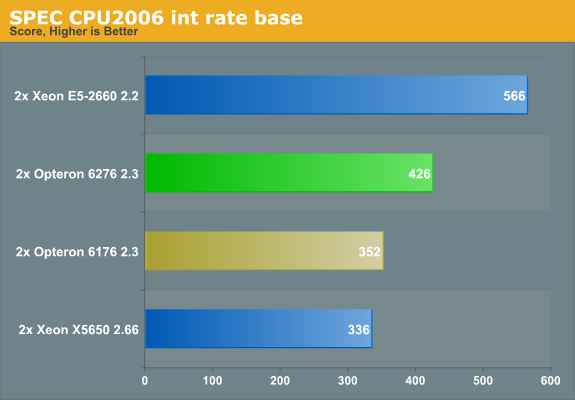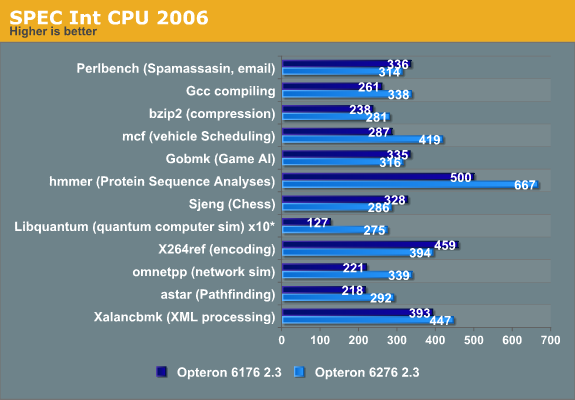The Bulldozer Aftermath: Delving Even Deeper
by Johan De Gelas on May 30, 2012 1:15 AM ESTNext stop: SPEC CPU2006 Int Rate
There is no denying that SPEC CPU2006 was never one of our favorite benchmarks in the Professional IT section of AnandTech. Although it is the standard benchmark of most CPU designers and academic researchers, it is far from a real world benchmark for most professional IT users.
For starters, a typical SPEC CPU2006 benchmark consists of running as many SPEC CPU2006 instances as there are cores available in the machine. The SPEC CPU2006 instances run completely independently from each other, so there are much fewer locks or other synchronization mechanisms at work: the benchmark scales almost perfectly as long as there is enough bandwidth available. Unfortunately, that is not how the majority of business software behaves: databases have high locking overhead and most applications need some synchronization.
Secondly, most of the subtests are related to gaming and simulations (HPC). Typically these applications are much more processing intensive and achieve a higher IPC than your average business application.
Lastly, the source code of the SPEC CPU2006 tests is compiled with extremely aggressively tuned compiler settings and compilers that are less used in the rest of the IT world. Few SPEC CPU2006 results are compiled with gcc and Microsoft's Visual Studio, for example.
However, it would be a step too far to call SPEC CPU2006 useless. From a high level perspective, the scores of SPEC CPU2006 show a strong correlation with L2/L3 cache misses, cache latency, and to a lesser degree branch prediction, just like many business applications. Given similar platforms (like Intel Nehalem and AMD's Shanghai), the CPU SPEC2006 Int score gives a vague idea of which CPU has the most raw integer crunching power, although it overemphasizes memory bandwidth and core count.
To understand the weaknesses and strengths of a certain CPU architecture, even in server workloads, there is no better test than SPEC CPU2006. The first reason is that it has been profiled by so many different people from academia to engineers. If we zoom in on the subtests we can derive a lot of information as we know exactly how these applications behave: there have been lots of performance characterization papers going into great detail.
The second reason is that SPEC CPU2006 tests are compiled with the most optimal compilers and compiler options available at a certain point in time. This gives us some insight into the "real" (e.g. future) potential of a processor. We can exclude the possibility that a processor performs badly because some legacy piece of code is detrimental to the performance. If the CPU cannot score well with these kinds of binaries, it never will!
Auto-parallelization made the normal single-threaded SPEC CPU benchmarks very hard to read. We turn to the rate version instead. Since it scales almost perfectly, it is relatively easy to deduce single-threaded performance from the SPEC rate numbers--on the condition that cache interference and bandwidth bottlenecks do not blur the picture too much, so we have to be careful with those benchmarks that miss the L2 cache a lot. The current CPU2006 int scores are as follows:

The Xeon E5 is the most efficient clock for clock, core for core. But let us compare the Opteron 6276 (2.3GHz, 16-core Bulldozer) and the Opteron 6176 (2.3GHz, 12-core Magny-Cours) in the subtests.

You can immediately derive from these numbers that the "Bulldozer" architecture has a very different architecture profile than Magny-Cours (which was based on the improved Barcelona architecture, Istanbul). Libquantum, omnetpp and mcf show larger performance boosts than you might expect from the 33% higher corecount. These benchmarks show that in some scenarios, Bulldozer can even increase the IPC compared to its predecessor.
We also notice that Bulldozer has some serious weaknesses compared to its predecessor, as performance decreases in the Perlbench, the game AI (gobmk), the chess (Sjeng), and the x264 encoding subtests. And although it is not uncommon that a new architecture fails to beat the previous architecture in every benchmark, it is not a good sign that even a 33% core count cannot overcome the IPC decrease in a very good scaling benchmark. If we try to understand what makes these subtests different from the others, we can get an idea of what kind of software makes Bulldozer choke. This in turn can help us to understand if relatively small tweaks can help future Opterons.










84 Comments
View All Comments
Aone - Monday, June 4, 2012 - link
Bulldozer's conception was wrong from the scratch.I told it a few time, let's me explain it here again.
I'm sure everyone of you do remember AMD's own words "one BD module has 80% of throughput of two independent cores".
What does this mean in figures?
Let's take the performance of one core as 1.0 point. Therefore two BD modules would have 3.2 points or in other words less than 10% than 3.0 (performance of three independent cores).
Should I remind that with development of independent cores AMD wouldn't had wasted resources (engineering, transistors, money and time) on design and debugging the shared logic. The chip could have been much smaller due to the fact that the chip would have had only 1MB L2 and 2MB L3 per each core and no shared logic. And all of those released resources could have been allocated for development of a more advanced core.
You see that packing two cores inside a one module was wrong even on the conceptional level. I'm very curious who was the main supporter and decision maker of this approach in AMD.
AMD must through away BD conception and return to standard practice. The only question remains: Does AMD have long enough TTL to do it?
BTW, I recommend to look through Spec results again. The comparison of 12c Opteron 62xx w/ 12c Opteron 61xx is of special interest. And let's not forget that Opteron 62xx submissions have higher freq, faster memory and as well as more advanced compiler version and extended instruction set.
TC2 - Monday, June 18, 2012 - link
I'm agree in 100%!!!The BD uA is "unsuccessful" port from graphics uA. There is many and major drawbacks! Note for example one - to write an optimal software you must adopt an application at algorithmic level (in sense of thread specialization)! This is because the both BD-cores are not the same! Also they shares L1 IC, the number of elements is high, ... and many others uA weaknesses.
evolucion8 - Tuesday, June 17, 2014 - link
Northwood was 20 stage pipelines and Prescott was 31, not 39...tipoo - Wednesday, October 8, 2014 - link
Where is the aftermath?"But what about the fourth show stopper? That is probably one of the most interesting ones because it seems to show up (in a lesser degree) in Sandy Bridge too. However, we're not quite ready with our final investigations into this area, so you'll have to wait a bit longer. To be continued...."